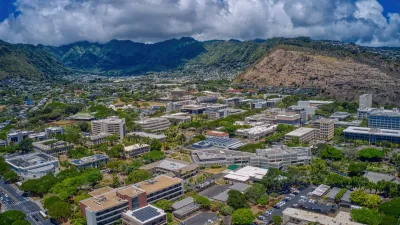All too often when we think of 'transportation,' especially transit, our thoughts are overtaken by visions of public transit. Yet, private transit also plays a key role.
Drive around nearly any town, from the largest city, to the smallest 'burb, and you'll see the shuttle buses, often emblazoned with company logos. However visible, these forms of transit are often overlooked as important pieces of an area's transportation network. Sarah Jo Peterson, of Urban Land Magazine writes, "[t]he data providers who track transit service often do not recognize that these privately provided services even exist, but once one starts looking for such "hidden transit," it begins to appear across the country, in urban, suburban, and rural locations. And it is helping people get access to jobs, personal services, and shopping."
These private forms of transit commonly serve campuses and large facilities, such as universities, hospitals, and senior living homes. But, over the last few decades, "hidden" transit has expanded into suburban office parks, as well, in an effort to disincentivize single-person automobile travel between home and work. With efforts to achieve greater sustainability, as well as an aging populace, private transit may take on an even greater role in the nation's transportation networks in the future.
"Implementing a private transit service can help a company achieve many goals," says Peterson, "including minimizing the need for parking, attracting talent, keeping suburban locations competitive, and achieving environmental sustainability targets."
FULL STORY: Hidden Transit: How Companies are Going the Last Mile

Alabama: Trump Terminates Settlements for Black Communities Harmed By Raw Sewage
Trump deemed the landmark civil rights agreement “illegal DEI and environmental justice policy.”

Study: Maui’s Plan to Convert Vacation Rentals to Long-Term Housing Could Cause Nearly $1 Billion Economic Loss
The plan would reduce visitor accommodation by 25% resulting in 1,900 jobs lost.

Planetizen Federal Action Tracker
A weekly monitor of how Trump’s orders and actions are impacting planners and planning in America.

Wind Energy on the Rise Despite Federal Policy Reversal
The Trump administration is revoking federal support for renewable energy, but demand for new projects continues unabated.

Passengers Flock to Caltrain After Electrification
The new electric trains are running faster and more reliably, leading to strong ridership growth on the Bay Area rail system.

Texas Churches Rally Behind ‘Yes in God’s Back Yard’ Legislation
Religious leaders want the state to reduce zoning regulations to streamline leasing church-owned land to housing developers.
Urban Design for Planners 1: Software Tools
This six-course series explores essential urban design concepts using open source software and equips planners with the tools they need to participate fully in the urban design process.
Planning for Universal Design
Learn the tools for implementing Universal Design in planning regulations.
Caltrans
Smith Gee Studio
Institute for Housing and Urban Development Studies (IHS)
City of Grandview
Harvard GSD Executive Education
Toledo-Lucas County Plan Commissions
Salt Lake City
NYU Wagner Graduate School of Public Service





























